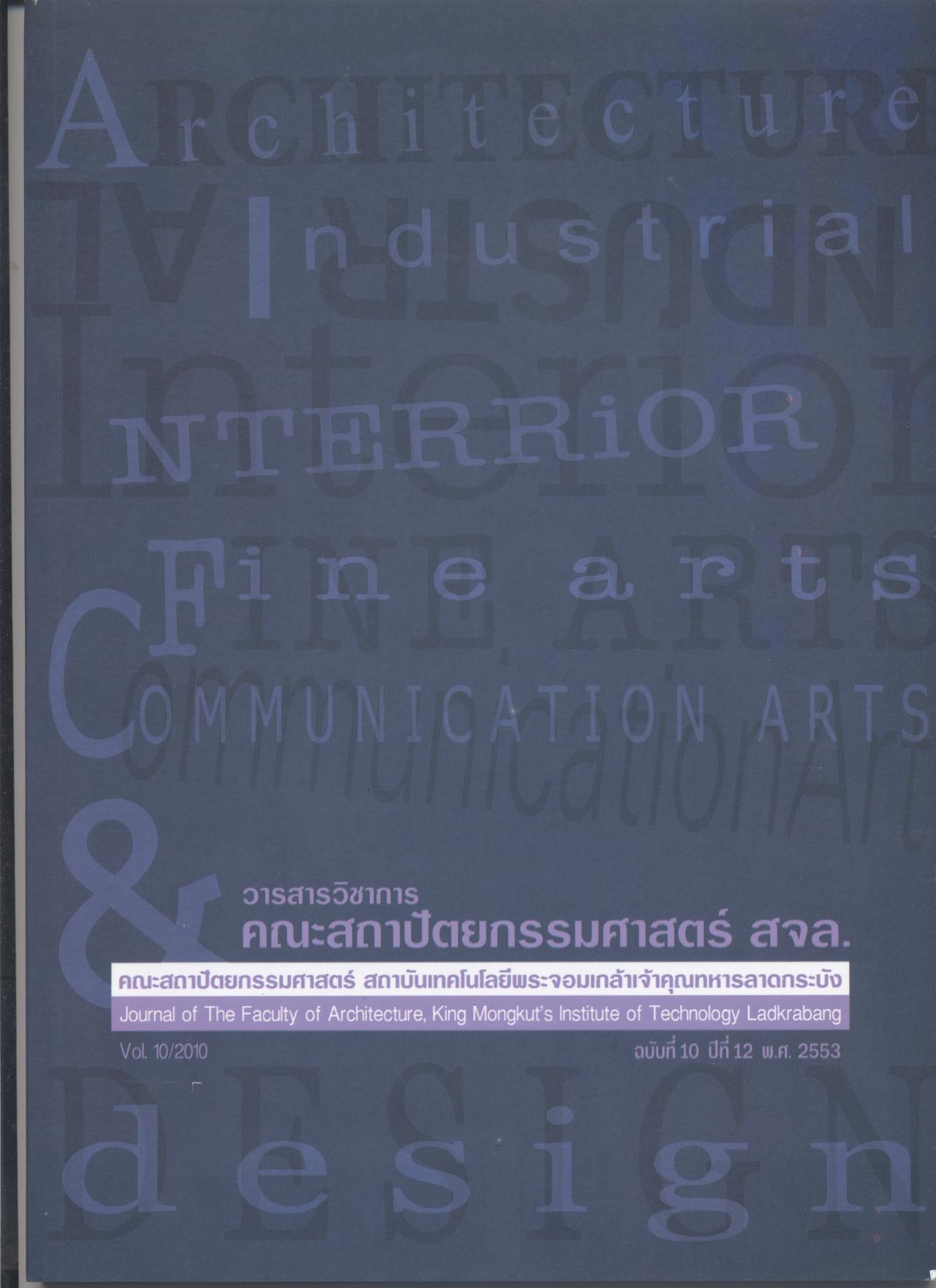พฤติกรรมการเดินทางกับมลพิษทางอากาศ ในพื้นที่ที่มีความสมดุลระหว่างที่อยู่อาศัย และแหล่งงานต่างกัน
Main Article Content
Abstract
บทคัดย่อ
กรุงเทพมหานคร เป็นพื้นที่ที่มีปัญหามลพิษทางอากาศที่เห็นได้อย่างชัดเจนอันเนื่องจากการจราจรติดขัด และการขาดความสมดุลระหว่างที่อยู่อาศัยและแหล่งงาน โดยเฉพาะในเขตเมืองชั้นในที่มีจำนวนงานมาก จึงดึงดูดให้มีปริมาณการเดินทางสูงในขาเข้าเมืองในตอนเช้า และขาออกจากเมืองในตอนเย็น จากปัญหาดังกล่าวจึงทำให้การศึกษาในครั้งนี้มุ่งเน้นเพื่อหาความสัมพันธ์ระหว่างพฤติกรรมการเดินทางกับสถานที่ตั้งที่ทำงาน, ระยะทาง, วิธีการเดินทาง และมลพิษทางอากาศ ในพื้นที่ตั้งที่ทำงานต่างกัน โดยได้รวบรวมข้อมูลเอกสารประกอบการสำรวจภาคสนามและการสัมภาษณ์ กลุ่มตัวอย่างที่พักอาศัยและทำงานอยู่ในพื้นที่ จำนวน 300 ตัวอย่าง ใน 3 พื้นที่ศึกษา ได้แก่ เขตบางรักเป็นกรณีศึกษาของพื้นที่งานมาก เขตบางนาเป็นกรณีศึกษาของพื้นที่สมดุล และเขตสายไหมเป็นกรณีศึกษาของพื้นที่บ้านมาก (โดยในการแบ่งพื้นที่ได้อ้างอิงตามเกณฑ์ผังเมืองกรุงเทพมหานคร ฉบับ เอ็มไอที, 2538) ผลจากการวิเคราะห์จากการจำแนกประเภทยานพาหนะ พบว่า กลุ่มตัวอย่างที่เดินทางโดยรถยนต์ส่วนตัว มีปริมาณการปล่อยก๊าซคาร์บอนไดออกไซด์ (CO2) สูงสุด โดยเฉพาะกลุ่มตัวอย่างที่พักอาศัยอยู่ในพื้นที่บ้านมาก และกลุ่มตัวอย่างที่มีปริมาณก๊าซคาร์บอนไดออกไซด์ (CO2) ต่ำที่สุด ได้แก่ กลุ่มตัวอย่างที่พักอาศัยอยู่ในพื้นที่งานมาก ที่เดินทางด้วยรถโดยสารสาธารณะ ส่วนปริมาณฝุ่นละอองขนาดเล็ก (PM10) พบว่า กลุ่มตัวอย่างที่พักอาศัยอยู่ในพื้นที่งานมาก ที่เดินทางด้วยรถยนต์ส่วนตัว มีปริมาณการปล่อยมากที่สุด และกลุ่มตัวอย่างที่พักอาศัยอยู่ในพื้นที่งานมาก ที่เดินทางด้วยรถโดยสารสาธารณะ มีปริมาณฝุ่นละอองขนาดเล็กน้อยที่สุด ดังนั้นในกรณีพื้นที่งานมาก (เขตบางรัก) ควรจะส่งเสริมหรือเพิ่มแรงจูงใจให้มีการใช้รถโดยสารสาธารณะเพิ่มมากขึ้น รวมถึงมีมาตรการในการสร้างที่พักอาศัยในแนวดิ่งที่เหมาะสม เพื่อให้รองรับกับงานที่มีอยู่ และที่กำลังจะเกิดขึ้น อย่างไรก็ตามควรพิจารณาถึงศักยภาพของสาธารณูปโภคและสาธารณูปการ ที่รองรับกับแรงงานส่วนนี้ด้วย ในกรณีพื้นที่บ้านมาก (เขตสายไหม) กรุงเทพมหานครควรส่งเสริมธุรกิจขนาดย่อม (SMEs) ในพื้นที่เขตสายไหมและพื้นที่อื่น ๆ โดยรอบ โดยอาจส่งเสริมผู้ประกอบการที่ต้องการแรงงานกลุ่มนี้ หรือหามาตรการหรือการให้แรงจูงใจต่าง ๆ เช่น การปลอดภาษี หรือสร้างตลาดที่เหมาะสมกับความต้องการของแรงงานกลุ่มตัวอย่างที่พักอาศัยอยู่ในพื้นที่นี้
คำสำคัญ : ความสมดุลระหว่างบ้านและงาน, พฤติกรรมการเดินทาง, มลพิษทางอากาศ
Abstract
The Bangkok Metropolitan Area has encountered air pollution problem due to traffic congestion and job-housing imbalance. It is particularly in inner city--a center of various jobs--that is a magnet for the worker commuting in to work in the morning and out to home in the evening. The study, therefore, aims to find out travel behavior in the areas of different job and housing ratio and its relation to air pollution. To classify the areas of different job and housing, the study applied the criteria of Bangkok city plan of MIT, 2538 B.E., and then divided Bangkok into three zones: job-rich area (Bangrak); job-housing balance area (Bangna); and house-rich area (Saimai). The data were gathered in types of field survey and 300 questionnaire interviews for those who work in their living areas.
The results show that the respondents traveling by private vehicles emit the highest Carbon Dioxide (CO2), especially those living in house–rich area. The lowest CO2 emission finds in those traveling by public transport and most of them living in job-rich area. For particle matter (PM10) emission, the respondents living in job-rich area and commuting by private vehicles emit the highest PM10. The respondents living in job-rich area and traveling by public transport produce the lowest PM10 emission. The solutions for the job-rich area (Bangrak District) are to encourage people to use public transport and to formulate policy on supporting living in vertical building with a consideration of the numbers of existing and future jobs and the capacity of the existing infrastructure and public services in residential districts. In the case of house-rich area (Saimai District), creating jobs for the residents in Samai is a primary concern. Some incentives should be offered to Small and Medium Enterprises (SMEs) and its neighboring districts e.g. BOI or duty free areas for local workforce employment.
Keywords : Job-Housing Balance, Travel Behavior, Air Pollution
Article Details
This work is licensed under a Creative Commons Attribution-NonCommercial-ShareAlike 4.0 International License.
Copyright Transfer Statement
The copyright of this article is transferred to Journal of The Faculty of Architecture King Mongkut's Institute of Technology Ladkrabang with effect if and when the article is accepted for publication. The copyright transfer covers the exclusive right to reproduce and distribute the article, including reprints, translations, photographic reproductions, electronic form (offline, online) or any other reproductions of similar nature.
The author warrants that this contribution is original and that he/she has full power to make this grant. The author signs for and accepts responsibility for releasing this material on behalf of any and all co-authors.

